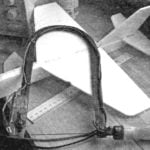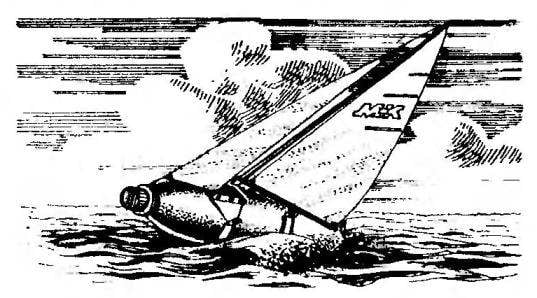The steering device consists of a hinge the rudder and steering the pen. The hinge U — shaped bracket, curved strips of duralumin with a thickness of 1,5 mm. Baller — cut steel wire with a diameter of 3 mm, one end of which is threaded MZ. The steering is feather cut out of sheet aluminum with a thickness of 1 mm. Bracket is affixed to the body of the bottle bolt with nut, which in its oelstrom the bottom of the drilled hole with a diameter of 3 mm. For mounting brackets will have to get or make a long screwdriver; mounting bolt is most convenient to attach to its tip in the usual clay — this will give you the opportunity to enter the bolt through the neck of the bottle into the hole at its bottom. Do not forget to put under the bolt head, rubber washer, providing a sealed enclosure.
The mast, representing a truncated cone with a base diameter of 8 and 4 mm and a height of 435 mm, vystragivaetsja from straight grained pine slats, geeks of the mainsail and headsail from pine slats with a cross-section 5×3 mm. a Hinge connecting the mast and the boom of the mainsail, made of wire, the device shown in the drawings. Fixing the mast on a sailboat — with the help of the forestay and a pair of cables made of nylon twine.
Sail mini yachts it is best to glue from a thin Mylar film thickness of 0.05—0.06 mm using Scotch adhesive tape. Docked sail with mast and boom — pockets formed by the material of the sail and tape. Sail battens are thin plastic strips (you can cut them out from the cylindrical part of the bottle) attached to the sail with tape.
The dimensions of the mast, sail and keel shown in the drawings is designed for the use case of laterality bottle. When using a capacity larger (e.g. two-liter) all linear dimensions should increase by approximately 30 percent.
The second sailboat, made by the scheme of a catamaran, little more complicated — it is quite possible to participate in the competition models bramahadev.
For the manufacture of hulls of a catamaran will take four half-liter bottles (however, the fit bottles of any capacity — from 0.6 up to 2 liters). A pair of plastic vessels in a single frame is joined using the M5 bolt, nut and washers — two steel and two rubber. I must say that the shape of the bottom parts of the bottles provides for a very rigid connection absolutely precise alignment in the case where the bottom tabs of one bottle fall into the bottom of the basin to another. For such a dock, however, you will need a special tool — a screwdriver with an elongated tip and a long Allen wrench.
The bridge of the catamaran form a longitudinal and four cross-beams, planed pine slats. On each of the crossbars is fixed to the cradle—the inner surface is treated in accordance with the bulge of the housing. Attachment of the housings to bridge — rubber tapes.
The keels of the catamaran cut out of sheet aluminum 2 mm thick and attached to the housings by rubber bands — two of those used for coupling housings and bridge. At the end of each fixed lead keel bulb.
The steering device is almost the same as a “liter” mini-yacht, but instead of the bracket-hinge of the rudder uses a dural collar fixed on the tube housing.
The mast of the catamaran is a truncated cone with bases of 5 and 10 mm and a height of 920 mm, planed from straight grained pine slats. In the lower end of the mast with epoxy resin pasted spurs masts — steel rod 3 mm in diameter, projecting from the mast at 5 mm. Geeks headsail and mainsail are made of pine slats cross-section of 5×5 mm. the Mast and boom are joined in the same way as in “liter” mini-yacht.
The mast is fixed on the catamaran with a pair of guys and the forestay of durable nylon twine or fishing line. When stuffing the rigging, it is desirable to use the simplest lanyards.
Sails for a catamaran it is best to sew from thin air-tight fabric, which usually sew jackets. Before proceeding from a dense paper to make patterns of the sails, you only need to take into account the allowances on the exposed rear and bottom skinoren and education of the mast pocket. Cutting this material is preferably an electrosoldering iron with astrosatchel-ing a sting. When namatanai blanks sails is convenient to use rubber glue. To contracepti sails should be on the sewing machine with a zigzag — such seams allow the fabric to freely stretch without the formation of folds and wrinkles. Battens are fixed to the sail in tutu is to sail lat pockets.

“Polutorametrovaya” model yachts:
1 —forestay (nylon twine or fishing line); 2 — jib (Mylar film S0.05…0.06); 3 — the jib boom (pine, rack 5×3); 4 — casing (plastic bottle 1.5 litre): 5 — front poluchaut (duralumin, sheet s1,5, 2); 6 — MZ bolts and nuts of fastening of the keel; 7—bolts MZ nuts attaching the bulb; 8 — keel (plywood s5); 9 — bulb (lead); 10 — rear poluchaut (duralumin, sheet s1,5, 2); And — rudder (aluminum, sheet si); 12 — bracket-hinge shaft (duralumin, sheet s 1,5); 13 — nut MZ; 14 — a coupling bolt M4 with Hanka; 15 — tiller-rudder (steel, wire d3); 16 — poluchaut mast took into account (duralumin, sheet si,5); 17 —a bolt with a nut, MZ; 18 — gik (pine, rack 5×3); 19 — steps (beech or birch s15); 20 — Macha (pine, raked 8×8); 21 — the guy (nylon twine or fishing line): 22 — sheet (nylon twine, 2 pieces); 23 — MZ pinch bolt with nut; 24 — grog (Mylar film s0,05…0,06); 25 — plate (the plastic strips with a width of 5)

“Six-litre” model catamaran:
1 — forestay (nylon twine or fishing line); 2 — jib (synthetic fabric); 3 — boom furling headsail (pine, battens 5×5); 4 — front housing (plastic bottle 1.5 litre); 5 — keel (aluminum, sheet s2); 6 — bulb (lead); 7 — rubber band; 8 — back of the case (plastic bottle 1.5 litre); 9 — clamp with a hinge shaft (duralumin, sheet s1,5); 10 — steering pen (made of anodized aluminum, sheet s1); 11 — nut MZ; 12 — tiller-rudder (steel, wire d3); 13 — sheet (nylon twine); 14 — geek grog (pine, battens 5×5); 15 — grog (synthetic fabric); 16 — the guy (nylon twine or fishing line); 17 — plate (the plastic strips with a width of 5); 18 — the mast (pine, raked 10×10); 19 — longitudinal bridge (pine, rail 40×15): 20 — cross the bridge (pine, rail 30×15); 21 — mast Board (aluminum, sheet s2); 22 — MZ pinch bolt with nut
Rubber band conventionally not shown
The sea trials should be carried out with smooth mild wind. Properly adjusted, the sailboat should automatically maintain the direction of travel relative to the wind direction. If the model is or uvarivaetsja, it is necessary to shift the center of the sail relative to the center of lateral resistance, which move the mast (this mast to the Board is necessary to provide a series of holes under the spurs of the mast) or Keeley.
I. TEREKHOV
Recommend to read
 THERMOLASTIC
THERMOLASTIC
For a long time home of the wizard, use foam, which for all its wonderful qualities has a major drawback. when working, clogging the working area is extremely trudnoudalimyh crumbs. The... THE FOURTH HEIGHT
THE FOURTH HEIGHT
Trucks fourth generation of GAZ-3307 GAZ — 3309. Automakers used to call generations of a group of machines based on the single structural elements (frame, cabin, engine). And speaking...


